Comparative Study of Costing Methods
VerifiedAdded on 2021/04/24
|13
|1902
|43
AI Summary
The assignment compares the Gross Margin under three different costing methods: Split-Off Method, Physical Measure Method, and NRV Method. It provides calculations for soda, chlorine, and basalt products, including sales revenue, cost of material & conversion, transfer cost, processing cost, gross margin, and percentage. The results show significant differences in gross margin and percentage under each method, highlighting the importance of choosing the appropriate costing method for accurate financial analysis.
Contribute Materials
Your contribution can guide someone’s learning journey. Share your
documents today.

Running head: MANAGEMENT ACCOUNTING
Management Accounting
Name of the Student:
Name of the University:
Author Note
Management Accounting
Name of the Student:
Name of the University:
Author Note
Secure Best Marks with AI Grader
Need help grading? Try our AI Grader for instant feedback on your assignments.
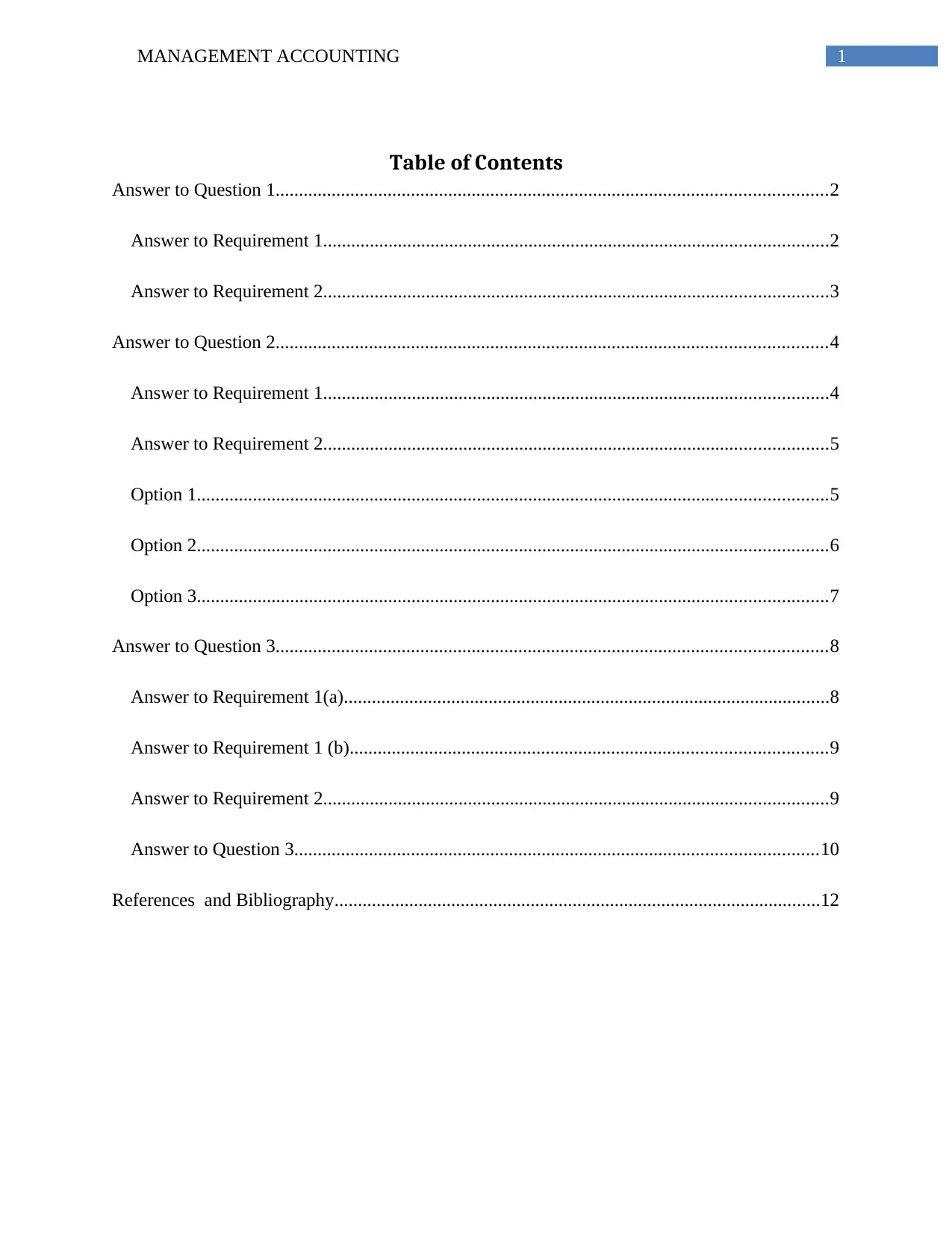
1MANAGEMENT ACCOUNTING
Table of Contents
Answer to Question 1......................................................................................................................2
Answer to Requirement 1............................................................................................................2
Answer to Requirement 2............................................................................................................3
Answer to Question 2......................................................................................................................4
Answer to Requirement 1............................................................................................................4
Answer to Requirement 2............................................................................................................5
Option 1.......................................................................................................................................5
Option 2.......................................................................................................................................6
Option 3.......................................................................................................................................7
Answer to Question 3......................................................................................................................8
Answer to Requirement 1(a)........................................................................................................8
Answer to Requirement 1 (b)......................................................................................................9
Answer to Requirement 2............................................................................................................9
Answer to Question 3................................................................................................................10
References and Bibliography........................................................................................................12
Table of Contents
Answer to Question 1......................................................................................................................2
Answer to Requirement 1............................................................................................................2
Answer to Requirement 2............................................................................................................3
Answer to Question 2......................................................................................................................4
Answer to Requirement 1............................................................................................................4
Answer to Requirement 2............................................................................................................5
Option 1.......................................................................................................................................5
Option 2.......................................................................................................................................6
Option 3.......................................................................................................................................7
Answer to Question 3......................................................................................................................8
Answer to Requirement 1(a)........................................................................................................8
Answer to Requirement 1 (b)......................................................................................................9
Answer to Requirement 2............................................................................................................9
Answer to Question 3................................................................................................................10
References and Bibliography........................................................................................................12

2MANAGEMENT ACCOUNTING
Answer to Question 1
Answer to Requirement 1
The net present value of a project refers to the difference between the present value of the
inflow of cash and the present value of the outflow of cash over a period of time. NPV
essentially reflects the profitability of an investment project. Furthermore, the internal rate of
return refers to the discount rate that essentially values the net present value (NPV) of all cash
flows in regards to a particular project that is equal to zero. It should be noted here that the NPV
and IRR are derived from the same formula. The issue presented in the question is that the two
projects have been considered, Project A and B. An initial investment of AED 11,000 is
required. The cash inflows occur at the end of each year. Therefore, the following computations
have been carried out on the basis of the given considerations (Magni & Martin, 2017).
Req.1:
Year Project A Project B
0
AED -
11,000
AED -
11,000
1 AED 1,000 AED 5,000
2 AED 2,000 AED 4,000
3 AED 3,000 AED 3,000
4 AED 4,000 AED 2,000
5 AED 5,000 AED 1,000
Required Rate
of Return 8% 8%
NPV AED 338.09
AED
1,473.26
IRR 9.00% 14.93%
Answer to Question 1
Answer to Requirement 1
The net present value of a project refers to the difference between the present value of the
inflow of cash and the present value of the outflow of cash over a period of time. NPV
essentially reflects the profitability of an investment project. Furthermore, the internal rate of
return refers to the discount rate that essentially values the net present value (NPV) of all cash
flows in regards to a particular project that is equal to zero. It should be noted here that the NPV
and IRR are derived from the same formula. The issue presented in the question is that the two
projects have been considered, Project A and B. An initial investment of AED 11,000 is
required. The cash inflows occur at the end of each year. Therefore, the following computations
have been carried out on the basis of the given considerations (Magni & Martin, 2017).
Req.1:
Year Project A Project B
0
AED -
11,000
AED -
11,000
1 AED 1,000 AED 5,000
2 AED 2,000 AED 4,000
3 AED 3,000 AED 3,000
4 AED 4,000 AED 2,000
5 AED 5,000 AED 1,000
Required Rate
of Return 8% 8%
NPV AED 338.09
AED
1,473.26
IRR 9.00% 14.93%
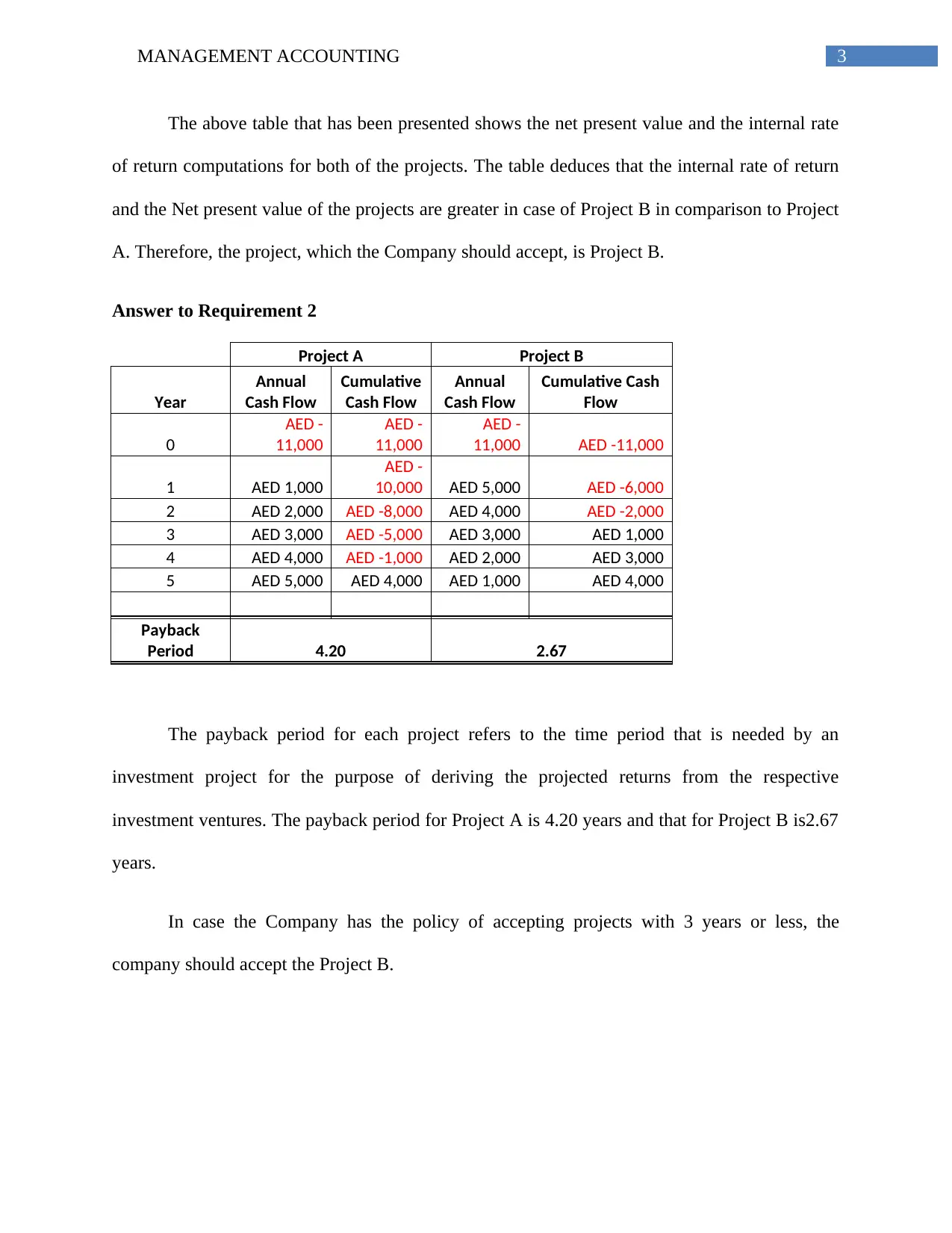
3MANAGEMENT ACCOUNTING
The above table that has been presented shows the net present value and the internal rate
of return computations for both of the projects. The table deduces that the internal rate of return
and the Net present value of the projects are greater in case of Project B in comparison to Project
A. Therefore, the project, which the Company should accept, is Project B.
Answer to Requirement 2
Project A Project B
Year
Annual
Cash Flow
Cumulative
Cash Flow
Annual
Cash Flow
Cumulative Cash
Flow
0
AED -
11,000
AED -
11,000
AED -
11,000 AED -11,000
1 AED 1,000
AED -
10,000 AED 5,000 AED -6,000
2 AED 2,000 AED -8,000 AED 4,000 AED -2,000
3 AED 3,000 AED -5,000 AED 3,000 AED 1,000
4 AED 4,000 AED -1,000 AED 2,000 AED 3,000
5 AED 5,000 AED 4,000 AED 1,000 AED 4,000
Payback
Period 4.20 2.67
The payback period for each project refers to the time period that is needed by an
investment project for the purpose of deriving the projected returns from the respective
investment ventures. The payback period for Project A is 4.20 years and that for Project B is2.67
years.
In case the Company has the policy of accepting projects with 3 years or less, the
company should accept the Project B.
The above table that has been presented shows the net present value and the internal rate
of return computations for both of the projects. The table deduces that the internal rate of return
and the Net present value of the projects are greater in case of Project B in comparison to Project
A. Therefore, the project, which the Company should accept, is Project B.
Answer to Requirement 2
Project A Project B
Year
Annual
Cash Flow
Cumulative
Cash Flow
Annual
Cash Flow
Cumulative Cash
Flow
0
AED -
11,000
AED -
11,000
AED -
11,000 AED -11,000
1 AED 1,000
AED -
10,000 AED 5,000 AED -6,000
2 AED 2,000 AED -8,000 AED 4,000 AED -2,000
3 AED 3,000 AED -5,000 AED 3,000 AED 1,000
4 AED 4,000 AED -1,000 AED 2,000 AED 3,000
5 AED 5,000 AED 4,000 AED 1,000 AED 4,000
Payback
Period 4.20 2.67
The payback period for each project refers to the time period that is needed by an
investment project for the purpose of deriving the projected returns from the respective
investment ventures. The payback period for Project A is 4.20 years and that for Project B is2.67
years.
In case the Company has the policy of accepting projects with 3 years or less, the
company should accept the Project B.
Secure Best Marks with AI Grader
Need help grading? Try our AI Grader for instant feedback on your assignments.
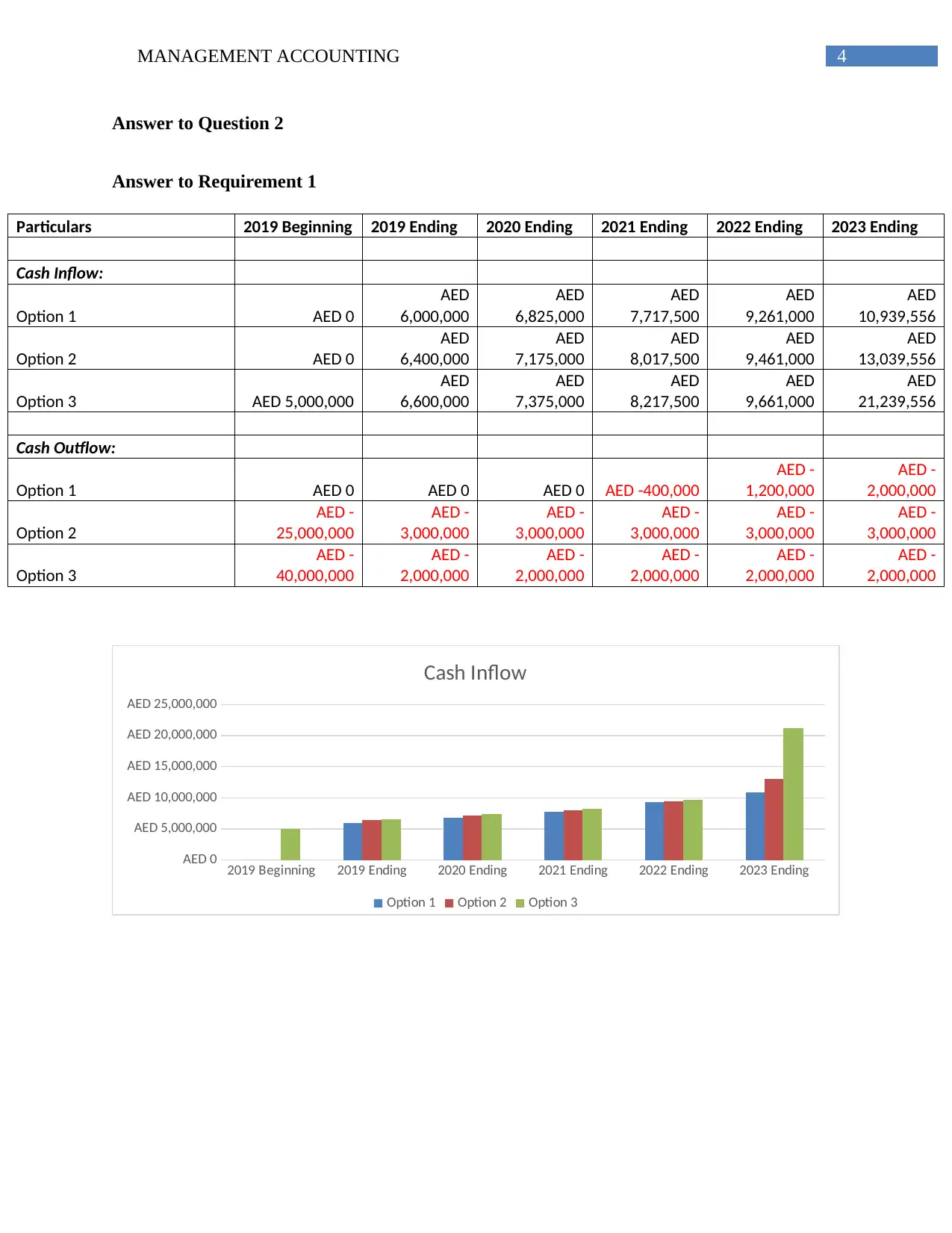
4MANAGEMENT ACCOUNTING
Answer to Question 2
Answer to Requirement 1
Particulars 2019 Beginning 2019 Ending 2020 Ending 2021 Ending 2022 Ending 2023 Ending
Cash Inflow:
Option 1 AED 0
AED
6,000,000
AED
6,825,000
AED
7,717,500
AED
9,261,000
AED
10,939,556
Option 2 AED 0
AED
6,400,000
AED
7,175,000
AED
8,017,500
AED
9,461,000
AED
13,039,556
Option 3 AED 5,000,000
AED
6,600,000
AED
7,375,000
AED
8,217,500
AED
9,661,000
AED
21,239,556
Cash Outflow:
Option 1 AED 0 AED 0 AED 0 AED -400,000
AED -
1,200,000
AED -
2,000,000
Option 2
AED -
25,000,000
AED -
3,000,000
AED -
3,000,000
AED -
3,000,000
AED -
3,000,000
AED -
3,000,000
Option 3
AED -
40,000,000
AED -
2,000,000
AED -
2,000,000
AED -
2,000,000
AED -
2,000,000
AED -
2,000,000
2019 Beginning 2019 Ending 2020 Ending 2021 Ending 2022 Ending 2023 Ending
AED 0
AED 5,000,000
AED 10,000,000
AED 15,000,000
AED 20,000,000
AED 25,000,000
Cash Inflow
Option 1 Option 2 Option 3
Answer to Question 2
Answer to Requirement 1
Particulars 2019 Beginning 2019 Ending 2020 Ending 2021 Ending 2022 Ending 2023 Ending
Cash Inflow:
Option 1 AED 0
AED
6,000,000
AED
6,825,000
AED
7,717,500
AED
9,261,000
AED
10,939,556
Option 2 AED 0
AED
6,400,000
AED
7,175,000
AED
8,017,500
AED
9,461,000
AED
13,039,556
Option 3 AED 5,000,000
AED
6,600,000
AED
7,375,000
AED
8,217,500
AED
9,661,000
AED
21,239,556
Cash Outflow:
Option 1 AED 0 AED 0 AED 0 AED -400,000
AED -
1,200,000
AED -
2,000,000
Option 2
AED -
25,000,000
AED -
3,000,000
AED -
3,000,000
AED -
3,000,000
AED -
3,000,000
AED -
3,000,000
Option 3
AED -
40,000,000
AED -
2,000,000
AED -
2,000,000
AED -
2,000,000
AED -
2,000,000
AED -
2,000,000
2019 Beginning 2019 Ending 2020 Ending 2021 Ending 2022 Ending 2023 Ending
AED 0
AED 5,000,000
AED 10,000,000
AED 15,000,000
AED 20,000,000
AED 25,000,000
Cash Inflow
Option 1 Option 2 Option 3
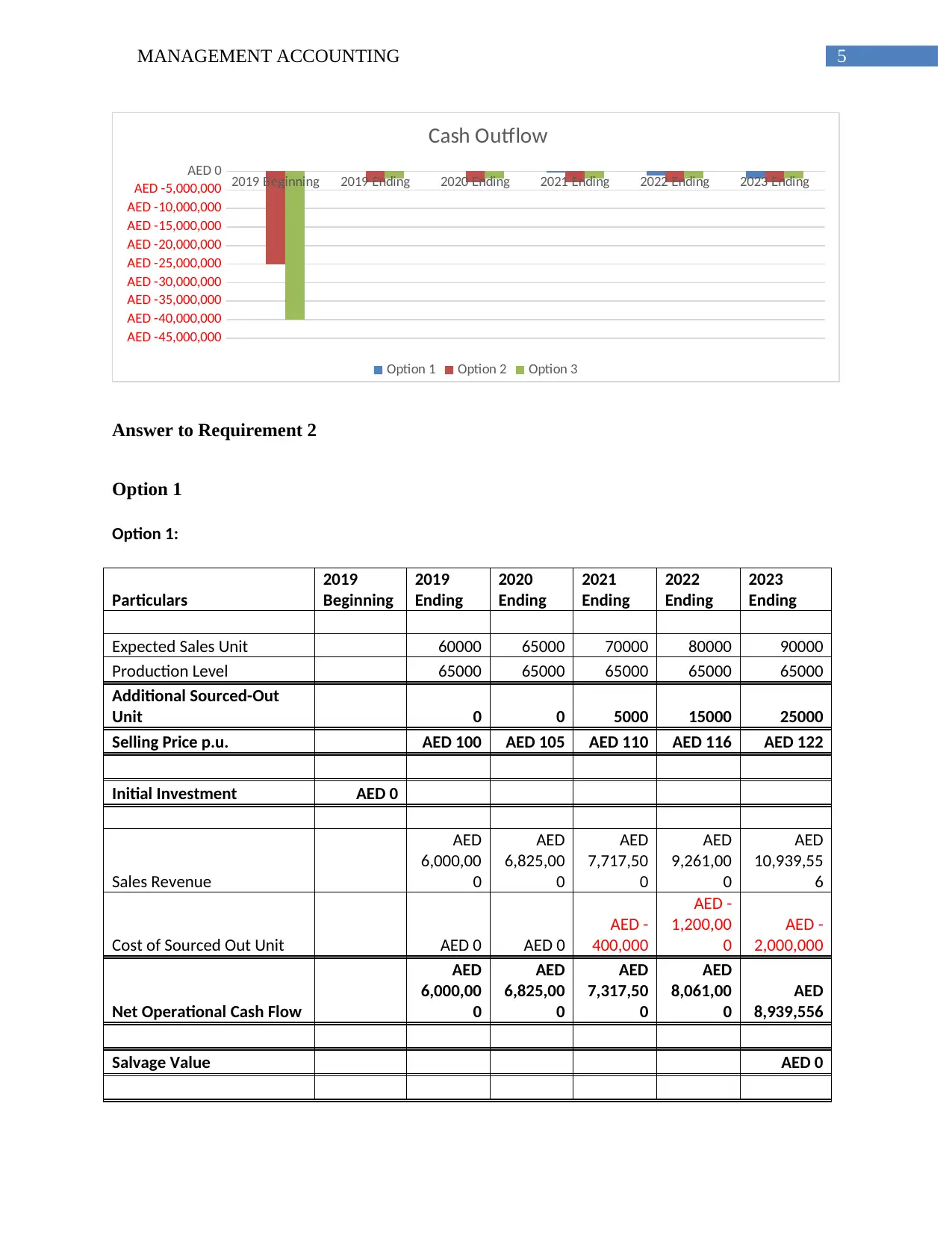
5MANAGEMENT ACCOUNTING
2019 Beginning 2019 Ending 2020 Ending 2021 Ending 2022 Ending 2023 Ending
AED -45,000,000
AED -40,000,000
AED -35,000,000
AED -30,000,000
AED -25,000,000
AED -20,000,000
AED -15,000,000
AED -10,000,000
AED -5,000,000
AED 0
Cash Outflow
Option 1 Option 2 Option 3
Answer to Requirement 2
Option 1
Option 1:
Particulars
2019
Beginning
2019
Ending
2020
Ending
2021
Ending
2022
Ending
2023
Ending
Expected Sales Unit 60000 65000 70000 80000 90000
Production Level 65000 65000 65000 65000 65000
Additional Sourced-Out
Unit 0 0 5000 15000 25000
Selling Price p.u. AED 100 AED 105 AED 110 AED 116 AED 122
Initial Investment AED 0
Sales Revenue
AED
6,000,00
0
AED
6,825,00
0
AED
7,717,50
0
AED
9,261,00
0
AED
10,939,55
6
Cost of Sourced Out Unit AED 0 AED 0
AED -
400,000
AED -
1,200,00
0
AED -
2,000,000
Net Operational Cash Flow
AED
6,000,00
0
AED
6,825,00
0
AED
7,317,50
0
AED
8,061,00
0
AED
8,939,556
Salvage Value AED 0
2019 Beginning 2019 Ending 2020 Ending 2021 Ending 2022 Ending 2023 Ending
AED -45,000,000
AED -40,000,000
AED -35,000,000
AED -30,000,000
AED -25,000,000
AED -20,000,000
AED -15,000,000
AED -10,000,000
AED -5,000,000
AED 0
Cash Outflow
Option 1 Option 2 Option 3
Answer to Requirement 2
Option 1
Option 1:
Particulars
2019
Beginning
2019
Ending
2020
Ending
2021
Ending
2022
Ending
2023
Ending
Expected Sales Unit 60000 65000 70000 80000 90000
Production Level 65000 65000 65000 65000 65000
Additional Sourced-Out
Unit 0 0 5000 15000 25000
Selling Price p.u. AED 100 AED 105 AED 110 AED 116 AED 122
Initial Investment AED 0
Sales Revenue
AED
6,000,00
0
AED
6,825,00
0
AED
7,717,50
0
AED
9,261,00
0
AED
10,939,55
6
Cost of Sourced Out Unit AED 0 AED 0
AED -
400,000
AED -
1,200,00
0
AED -
2,000,000
Net Operational Cash Flow
AED
6,000,00
0
AED
6,825,00
0
AED
7,317,50
0
AED
8,061,00
0
AED
8,939,556
Salvage Value AED 0

6MANAGEMENT ACCOUNTING
Net Cash Flow AED 0
AED
6,000,00
0
AED
6,825,00
0
AED
7,317,50
0
AED
8,061,00
0
AED
8,939,556
Discount Rate 10%
NPV
AED
25,135,74
5
Option 2
Option 2:
Particulars
2019
Beginning
2019
Ending
2020
Ending
2021
Ending
2022
Ending
2023
Ending
Expected Sales Unit 60000 65000 70000 80000 90000
Maximum Production
Level 100000 100000 100000 100000 100000
Additional Production 40000 35000 30000 20000 10000
Normal Selling Price p.u. AED 100 AED 105 AED 110 AED 116 AED 122
Lower Selling Price p.u. AED 10 AED 10 AED 10 AED 10 AED 10
Initial Investment
AED -
25,000,00
0
Normal Sales Revenue
AED
6,000,00
0
AED
6,825,00
0
AED
7,717,50
0
AED
9,261,00
0
AED
10,939,55
6
Sales at Lower Price
AED
400,000
AED
350,000
AED
300,000
AED
200,000
AED
100,000
Annual Operating Cost
AED -
3,000,00
0
AED -
3,000,00
0
AED -
3,000,00
0
AED -
3,000,00
0
AED -
3,000,000
Net Operational Cash
Flow
AED
3,400,00
0
AED
4,175,00
0
AED
5,017,50
0
AED
6,461,00
0
AED
8,039,556
Salvage Value
AED
2,000,000
Net Cash Flow AED - AED AED AED AED AED
Net Cash Flow AED 0
AED
6,000,00
0
AED
6,825,00
0
AED
7,317,50
0
AED
8,061,00
0
AED
8,939,556
Discount Rate 10%
NPV
AED
25,135,74
5
Option 2
Option 2:
Particulars
2019
Beginning
2019
Ending
2020
Ending
2021
Ending
2022
Ending
2023
Ending
Expected Sales Unit 60000 65000 70000 80000 90000
Maximum Production
Level 100000 100000 100000 100000 100000
Additional Production 40000 35000 30000 20000 10000
Normal Selling Price p.u. AED 100 AED 105 AED 110 AED 116 AED 122
Lower Selling Price p.u. AED 10 AED 10 AED 10 AED 10 AED 10
Initial Investment
AED -
25,000,00
0
Normal Sales Revenue
AED
6,000,00
0
AED
6,825,00
0
AED
7,717,50
0
AED
9,261,00
0
AED
10,939,55
6
Sales at Lower Price
AED
400,000
AED
350,000
AED
300,000
AED
200,000
AED
100,000
Annual Operating Cost
AED -
3,000,00
0
AED -
3,000,00
0
AED -
3,000,00
0
AED -
3,000,00
0
AED -
3,000,000
Net Operational Cash
Flow
AED
3,400,00
0
AED
4,175,00
0
AED
5,017,50
0
AED
6,461,00
0
AED
8,039,556
Salvage Value
AED
2,000,000
Net Cash Flow AED - AED AED AED AED AED
Paraphrase This Document
Need a fresh take? Get an instant paraphrase of this document with our AI Paraphraser
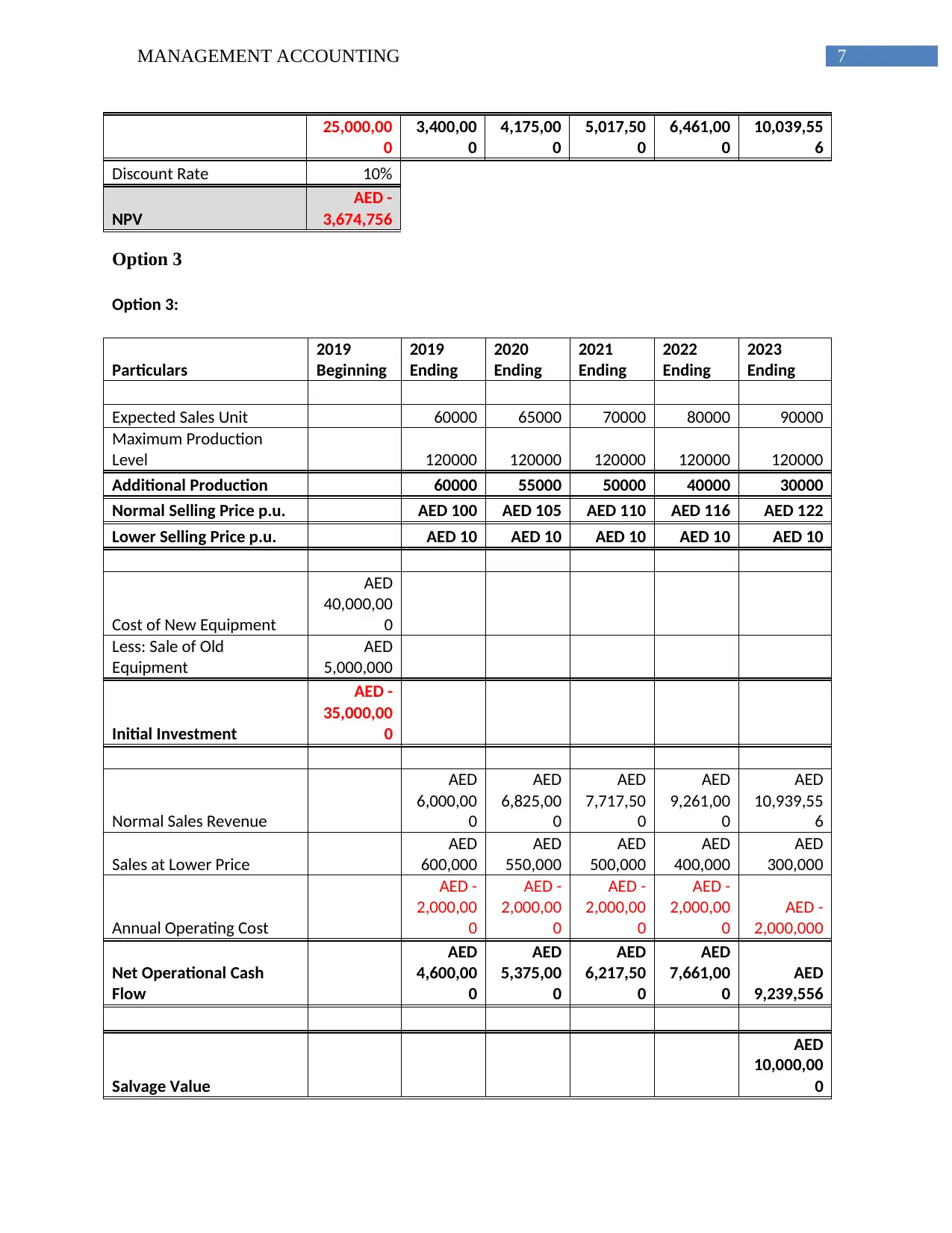
7MANAGEMENT ACCOUNTING
25,000,00
0
3,400,00
0
4,175,00
0
5,017,50
0
6,461,00
0
10,039,55
6
Discount Rate 10%
NPV
AED -
3,674,756
Option 3
Option 3:
Particulars
2019
Beginning
2019
Ending
2020
Ending
2021
Ending
2022
Ending
2023
Ending
Expected Sales Unit 60000 65000 70000 80000 90000
Maximum Production
Level 120000 120000 120000 120000 120000
Additional Production 60000 55000 50000 40000 30000
Normal Selling Price p.u. AED 100 AED 105 AED 110 AED 116 AED 122
Lower Selling Price p.u. AED 10 AED 10 AED 10 AED 10 AED 10
Cost of New Equipment
AED
40,000,00
0
Less: Sale of Old
Equipment
AED
5,000,000
Initial Investment
AED -
35,000,00
0
Normal Sales Revenue
AED
6,000,00
0
AED
6,825,00
0
AED
7,717,50
0
AED
9,261,00
0
AED
10,939,55
6
Sales at Lower Price
AED
600,000
AED
550,000
AED
500,000
AED
400,000
AED
300,000
Annual Operating Cost
AED -
2,000,00
0
AED -
2,000,00
0
AED -
2,000,00
0
AED -
2,000,00
0
AED -
2,000,000
Net Operational Cash
Flow
AED
4,600,00
0
AED
5,375,00
0
AED
6,217,50
0
AED
7,661,00
0
AED
9,239,556
Salvage Value
AED
10,000,00
0
25,000,00
0
3,400,00
0
4,175,00
0
5,017,50
0
6,461,00
0
10,039,55
6
Discount Rate 10%
NPV
AED -
3,674,756
Option 3
Option 3:
Particulars
2019
Beginning
2019
Ending
2020
Ending
2021
Ending
2022
Ending
2023
Ending
Expected Sales Unit 60000 65000 70000 80000 90000
Maximum Production
Level 120000 120000 120000 120000 120000
Additional Production 60000 55000 50000 40000 30000
Normal Selling Price p.u. AED 100 AED 105 AED 110 AED 116 AED 122
Lower Selling Price p.u. AED 10 AED 10 AED 10 AED 10 AED 10
Cost of New Equipment
AED
40,000,00
0
Less: Sale of Old
Equipment
AED
5,000,000
Initial Investment
AED -
35,000,00
0
Normal Sales Revenue
AED
6,000,00
0
AED
6,825,00
0
AED
7,717,50
0
AED
9,261,00
0
AED
10,939,55
6
Sales at Lower Price
AED
600,000
AED
550,000
AED
500,000
AED
400,000
AED
300,000
Annual Operating Cost
AED -
2,000,00
0
AED -
2,000,00
0
AED -
2,000,00
0
AED -
2,000,00
0
AED -
2,000,000
Net Operational Cash
Flow
AED
4,600,00
0
AED
5,375,00
0
AED
6,217,50
0
AED
7,661,00
0
AED
9,239,556
Salvage Value
AED
10,000,00
0
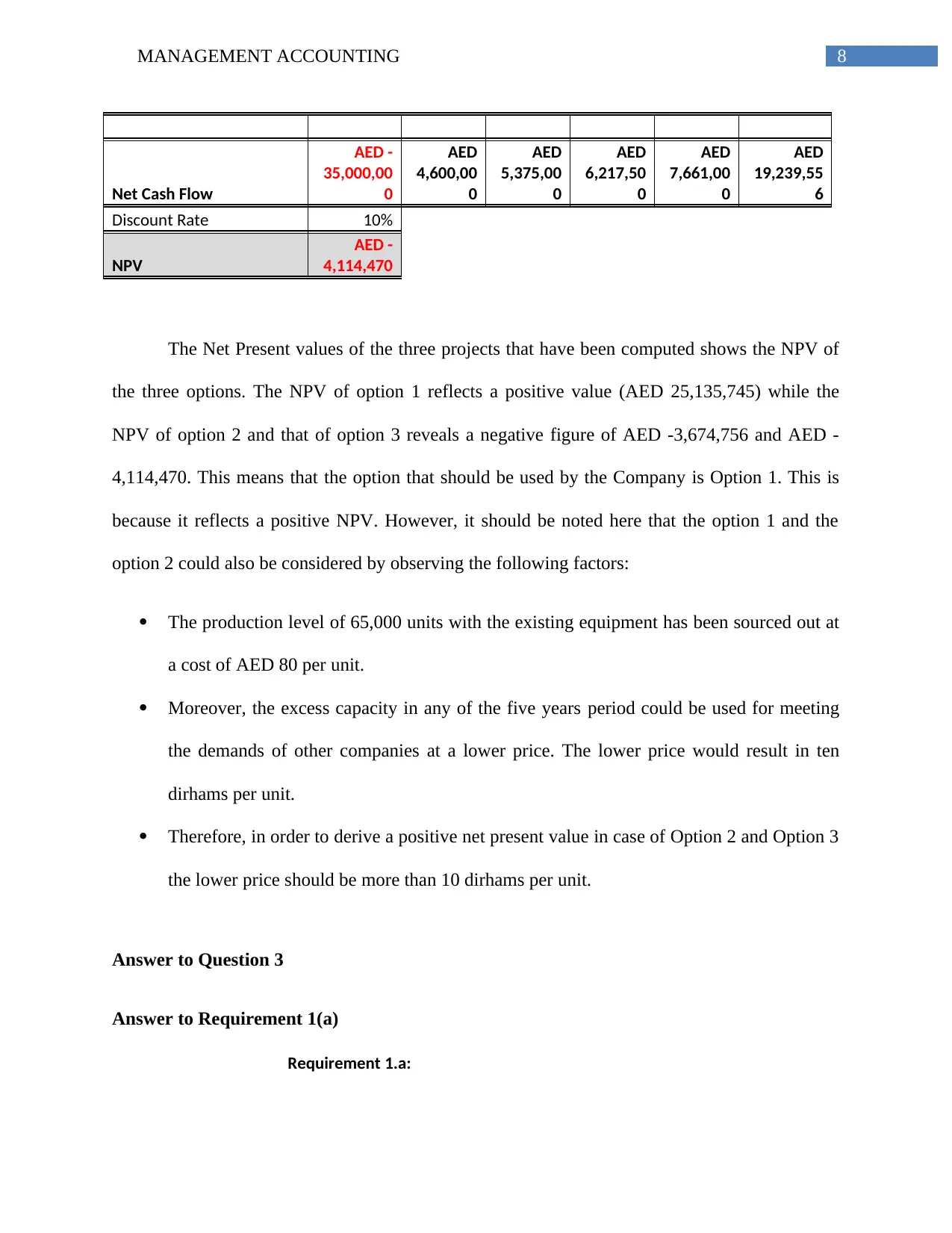
8MANAGEMENT ACCOUNTING
Net Cash Flow
AED -
35,000,00
0
AED
4,600,00
0
AED
5,375,00
0
AED
6,217,50
0
AED
7,661,00
0
AED
19,239,55
6
Discount Rate 10%
NPV
AED -
4,114,470
The Net Present values of the three projects that have been computed shows the NPV of
the three options. The NPV of option 1 reflects a positive value (AED 25,135,745) while the
NPV of option 2 and that of option 3 reveals a negative figure of AED -3,674,756 and AED -
4,114,470. This means that the option that should be used by the Company is Option 1. This is
because it reflects a positive NPV. However, it should be noted here that the option 1 and the
option 2 could also be considered by observing the following factors:
The production level of 65,000 units with the existing equipment has been sourced out at
a cost of AED 80 per unit.
Moreover, the excess capacity in any of the five years period could be used for meeting
the demands of other companies at a lower price. The lower price would result in ten
dirhams per unit.
Therefore, in order to derive a positive net present value in case of Option 2 and Option 3
the lower price should be more than 10 dirhams per unit.
Answer to Question 3
Answer to Requirement 1(a)
Requirement 1.a:
Net Cash Flow
AED -
35,000,00
0
AED
4,600,00
0
AED
5,375,00
0
AED
6,217,50
0
AED
7,661,00
0
AED
19,239,55
6
Discount Rate 10%
NPV
AED -
4,114,470
The Net Present values of the three projects that have been computed shows the NPV of
the three options. The NPV of option 1 reflects a positive value (AED 25,135,745) while the
NPV of option 2 and that of option 3 reveals a negative figure of AED -3,674,756 and AED -
4,114,470. This means that the option that should be used by the Company is Option 1. This is
because it reflects a positive NPV. However, it should be noted here that the option 1 and the
option 2 could also be considered by observing the following factors:
The production level of 65,000 units with the existing equipment has been sourced out at
a cost of AED 80 per unit.
Moreover, the excess capacity in any of the five years period could be used for meeting
the demands of other companies at a lower price. The lower price would result in ten
dirhams per unit.
Therefore, in order to derive a positive net present value in case of Option 2 and Option 3
the lower price should be more than 10 dirhams per unit.
Answer to Question 3
Answer to Requirement 1(a)
Requirement 1.a:
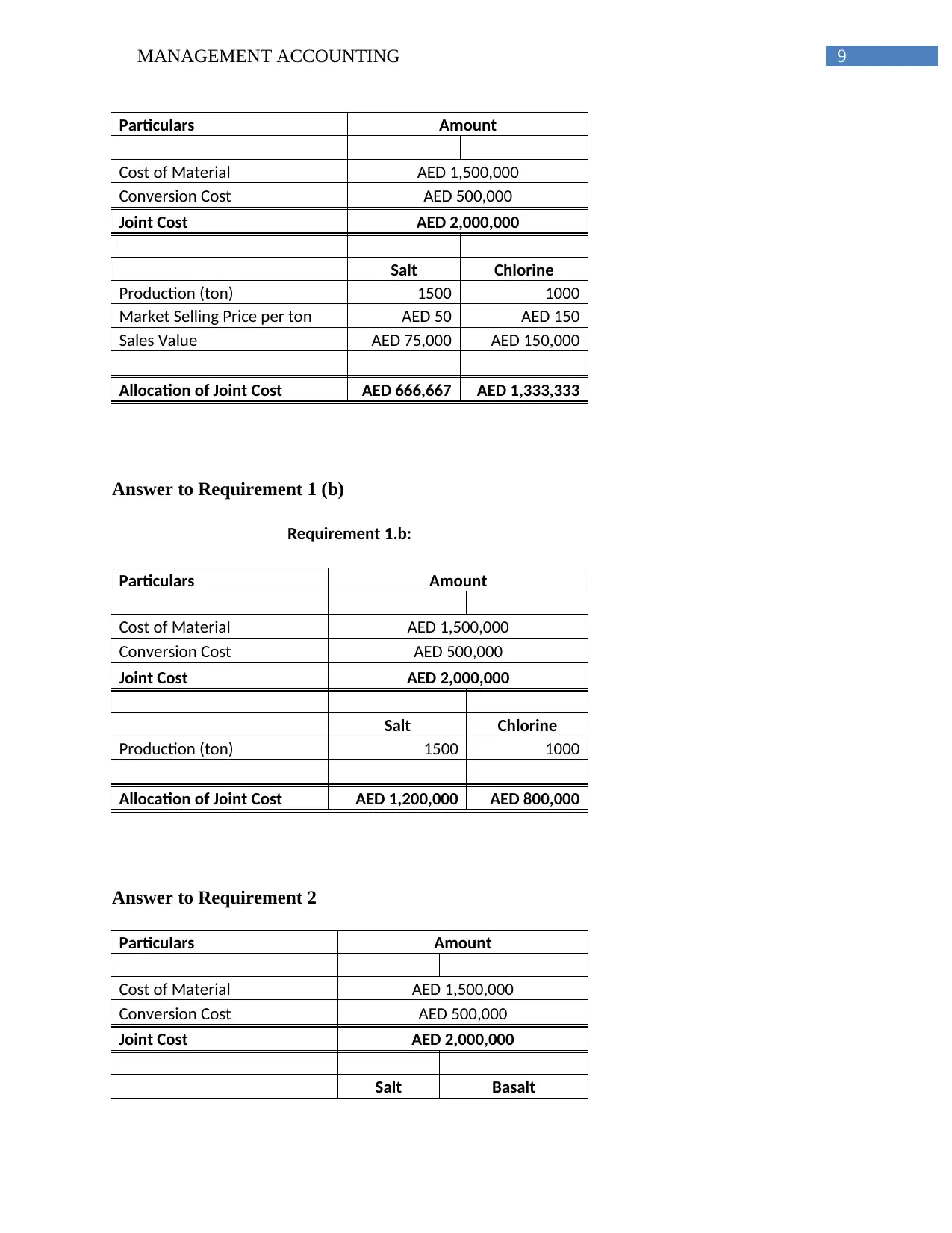
9MANAGEMENT ACCOUNTING
Particulars Amount
Cost of Material AED 1,500,000
Conversion Cost AED 500,000
Joint Cost AED 2,000,000
Salt Chlorine
Production (ton) 1500 1000
Market Selling Price per ton AED 50 AED 150
Sales Value AED 75,000 AED 150,000
Allocation of Joint Cost AED 666,667 AED 1,333,333
Answer to Requirement 1 (b)
Requirement 1.b:
Particulars Amount
Cost of Material AED 1,500,000
Conversion Cost AED 500,000
Joint Cost AED 2,000,000
Salt Chlorine
Production (ton) 1500 1000
Allocation of Joint Cost AED 1,200,000 AED 800,000
Answer to Requirement 2
Particulars Amount
Cost of Material AED 1,500,000
Conversion Cost AED 500,000
Joint Cost AED 2,000,000
Salt Basalt
Particulars Amount
Cost of Material AED 1,500,000
Conversion Cost AED 500,000
Joint Cost AED 2,000,000
Salt Chlorine
Production (ton) 1500 1000
Market Selling Price per ton AED 50 AED 150
Sales Value AED 75,000 AED 150,000
Allocation of Joint Cost AED 666,667 AED 1,333,333
Answer to Requirement 1 (b)
Requirement 1.b:
Particulars Amount
Cost of Material AED 1,500,000
Conversion Cost AED 500,000
Joint Cost AED 2,000,000
Salt Chlorine
Production (ton) 1500 1000
Allocation of Joint Cost AED 1,200,000 AED 800,000
Answer to Requirement 2
Particulars Amount
Cost of Material AED 1,500,000
Conversion Cost AED 500,000
Joint Cost AED 2,000,000
Salt Basalt
Secure Best Marks with AI Grader
Need help grading? Try our AI Grader for instant feedback on your assignments.
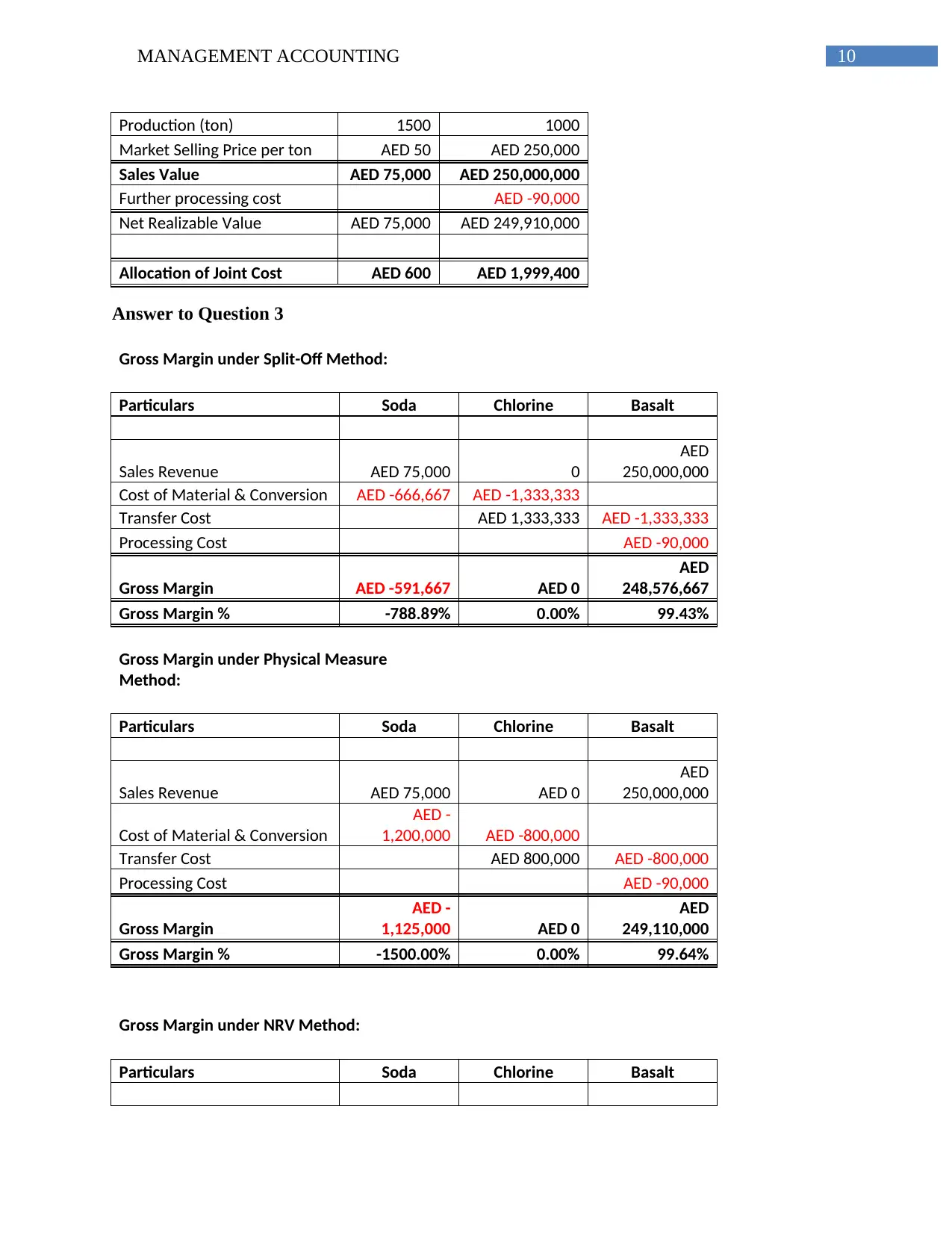
10MANAGEMENT ACCOUNTING
Production (ton) 1500 1000
Market Selling Price per ton AED 50 AED 250,000
Sales Value AED 75,000 AED 250,000,000
Further processing cost AED -90,000
Net Realizable Value AED 75,000 AED 249,910,000
Allocation of Joint Cost AED 600 AED 1,999,400
Answer to Question 3
Gross Margin under Split-Off Method:
Particulars Soda Chlorine Basalt
Sales Revenue AED 75,000 0
AED
250,000,000
Cost of Material & Conversion AED -666,667 AED -1,333,333
Transfer Cost AED 1,333,333 AED -1,333,333
Processing Cost AED -90,000
Gross Margin AED -591,667 AED 0
AED
248,576,667
Gross Margin % -788.89% 0.00% 99.43%
Gross Margin under Physical Measure
Method:
Particulars Soda Chlorine Basalt
Sales Revenue AED 75,000 AED 0
AED
250,000,000
Cost of Material & Conversion
AED -
1,200,000 AED -800,000
Transfer Cost AED 800,000 AED -800,000
Processing Cost AED -90,000
Gross Margin
AED -
1,125,000 AED 0
AED
249,110,000
Gross Margin % -1500.00% 0.00% 99.64%
Gross Margin under NRV Method:
Particulars Soda Chlorine Basalt
Production (ton) 1500 1000
Market Selling Price per ton AED 50 AED 250,000
Sales Value AED 75,000 AED 250,000,000
Further processing cost AED -90,000
Net Realizable Value AED 75,000 AED 249,910,000
Allocation of Joint Cost AED 600 AED 1,999,400
Answer to Question 3
Gross Margin under Split-Off Method:
Particulars Soda Chlorine Basalt
Sales Revenue AED 75,000 0
AED
250,000,000
Cost of Material & Conversion AED -666,667 AED -1,333,333
Transfer Cost AED 1,333,333 AED -1,333,333
Processing Cost AED -90,000
Gross Margin AED -591,667 AED 0
AED
248,576,667
Gross Margin % -788.89% 0.00% 99.43%
Gross Margin under Physical Measure
Method:
Particulars Soda Chlorine Basalt
Sales Revenue AED 75,000 AED 0
AED
250,000,000
Cost of Material & Conversion
AED -
1,200,000 AED -800,000
Transfer Cost AED 800,000 AED -800,000
Processing Cost AED -90,000
Gross Margin
AED -
1,125,000 AED 0
AED
249,110,000
Gross Margin % -1500.00% 0.00% 99.64%
Gross Margin under NRV Method:
Particulars Soda Chlorine Basalt
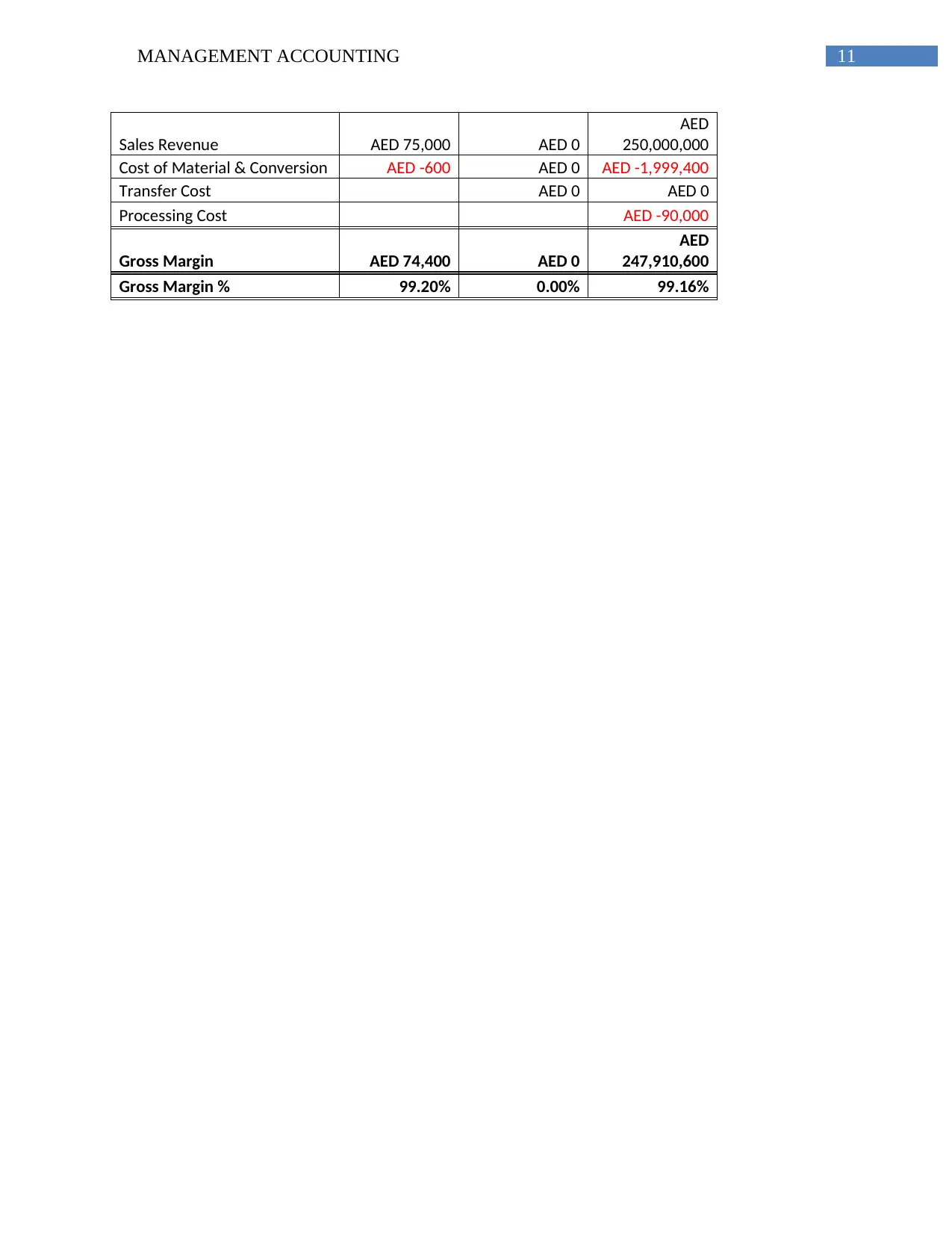
11MANAGEMENT ACCOUNTING
Sales Revenue AED 75,000 AED 0
AED
250,000,000
Cost of Material & Conversion AED -600 AED 0 AED -1,999,400
Transfer Cost AED 0 AED 0
Processing Cost AED -90,000
Gross Margin AED 74,400 AED 0
AED
247,910,600
Gross Margin % 99.20% 0.00% 99.16%
Sales Revenue AED 75,000 AED 0
AED
250,000,000
Cost of Material & Conversion AED -600 AED 0 AED -1,999,400
Transfer Cost AED 0 AED 0
Processing Cost AED -90,000
Gross Margin AED 74,400 AED 0
AED
247,910,600
Gross Margin % 99.20% 0.00% 99.16%
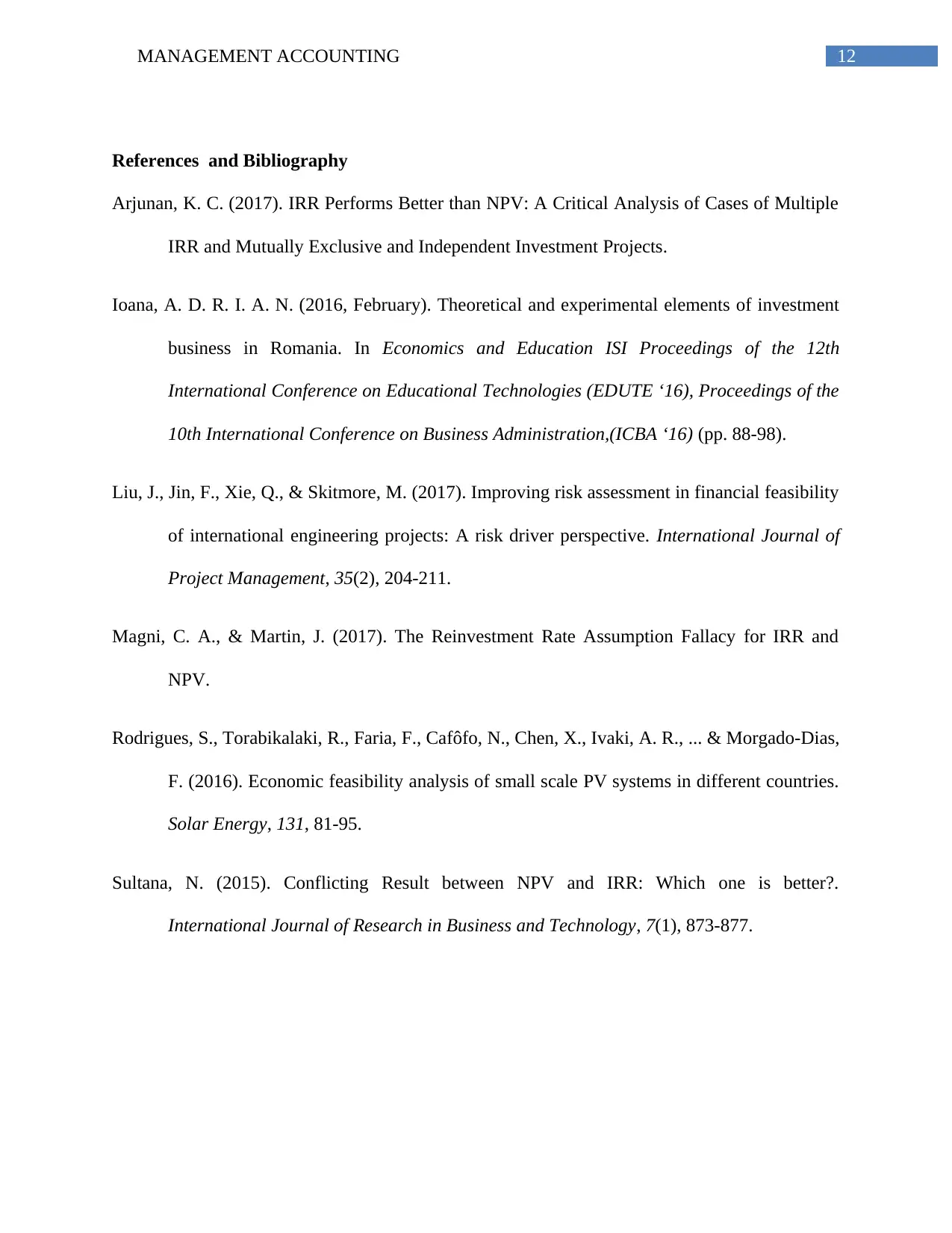
12MANAGEMENT ACCOUNTING
References and Bibliography
Arjunan, K. C. (2017). IRR Performs Better than NPV: A Critical Analysis of Cases of Multiple
IRR and Mutually Exclusive and Independent Investment Projects.
Ioana, A. D. R. I. A. N. (2016, February). Theoretical and experimental elements of investment
business in Romania. In Economics and Education ISI Proceedings of the 12th
International Conference on Educational Technologies (EDUTE ‘16), Proceedings of the
10th International Conference on Business Administration,(ICBA ‘16) (pp. 88-98).
Liu, J., Jin, F., Xie, Q., & Skitmore, M. (2017). Improving risk assessment in financial feasibility
of international engineering projects: A risk driver perspective. International Journal of
Project Management, 35(2), 204-211.
Magni, C. A., & Martin, J. (2017). The Reinvestment Rate Assumption Fallacy for IRR and
NPV.
Rodrigues, S., Torabikalaki, R., Faria, F., Cafôfo, N., Chen, X., Ivaki, A. R., ... & Morgado-Dias,
F. (2016). Economic feasibility analysis of small scale PV systems in different countries.
Solar Energy, 131, 81-95.
Sultana, N. (2015). Conflicting Result between NPV and IRR: Which one is better?.
International Journal of Research in Business and Technology, 7(1), 873-877.
References and Bibliography
Arjunan, K. C. (2017). IRR Performs Better than NPV: A Critical Analysis of Cases of Multiple
IRR and Mutually Exclusive and Independent Investment Projects.
Ioana, A. D. R. I. A. N. (2016, February). Theoretical and experimental elements of investment
business in Romania. In Economics and Education ISI Proceedings of the 12th
International Conference on Educational Technologies (EDUTE ‘16), Proceedings of the
10th International Conference on Business Administration,(ICBA ‘16) (pp. 88-98).
Liu, J., Jin, F., Xie, Q., & Skitmore, M. (2017). Improving risk assessment in financial feasibility
of international engineering projects: A risk driver perspective. International Journal of
Project Management, 35(2), 204-211.
Magni, C. A., & Martin, J. (2017). The Reinvestment Rate Assumption Fallacy for IRR and
NPV.
Rodrigues, S., Torabikalaki, R., Faria, F., Cafôfo, N., Chen, X., Ivaki, A. R., ... & Morgado-Dias,
F. (2016). Economic feasibility analysis of small scale PV systems in different countries.
Solar Energy, 131, 81-95.
Sultana, N. (2015). Conflicting Result between NPV and IRR: Which one is better?.
International Journal of Research in Business and Technology, 7(1), 873-877.
1 out of 13
Related Documents
Your All-in-One AI-Powered Toolkit for Academic Success.
+13062052269
info@desklib.com
Available 24*7 on WhatsApp / Email
![[object Object]](/_next/static/media/star-bottom.7253800d.svg)
Unlock your academic potential
© 2024 | Zucol Services PVT LTD | All rights reserved.



